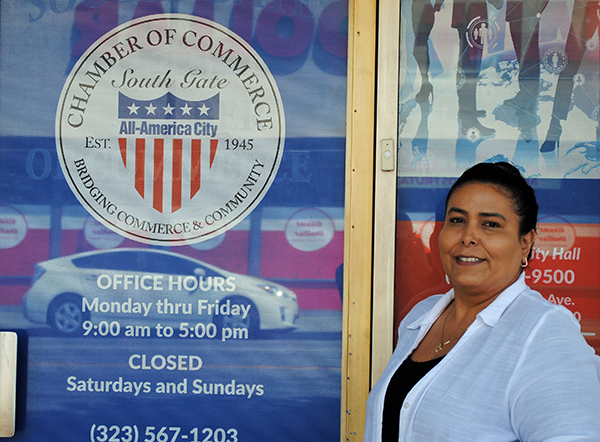Mike Clinton; left, and Kamau Coleman are two of four principles involved in the Redline Venice, a new hotel near the Venice Beach Boardwalk, the only Black-owned beachfront hotel in Venice. Through décor, the hotel’s rooms tell the stories of Black life in Venice over the years.
Courtesy photo.
By Darlene Donloe
Contributing Writer
VENICE — A new boutique hotel is making waves in Venice Beach with its unique blend of luxury and community-focused values.
The Redline Venice, at 20 17th Ave., under the umbrella brand the Redline Hotel Group, is more than just a place to stay — it’s a celebration of Black culture and a testament to the power of community, offering ocean views and an immersive experience that weaves together history, culture and relaxation.
Four friends — Kamau Coleman, Michael Clinton, Destinee Sales, and Sophea Samreth — came together in 2024 to launch the flagship property, making it the only Black-owned beachfront hotel in Venice.
The Redline name is a deliberate nod to the discriminatory practice of redlining, which once prevented Black people from buying homes in specific neighborhoods.
By reclaiming the term, the hotel’s founders, Coleman and Clinton, aim to challenge the status quo and promote economic empowerment within the Black community. With only 2% of hotel owners being Black, the Redline Hotel Group is on a mission to change that narrative.
Coleman, 53, and Clinton, 48, met 15 years ago while both were working in commercial real estate lending and hotel analysis.
Clinton owned two other hotels before The Redline, notably the Guest House, reportedly the largest Black-owned Antebellum in Natchez, Mississippi; and Weiss Lake Lodge in Centre, Alabama.
Coleman, who leads strategy, brand and expansion, secured the property from a family friend who decided to empty his properties and get out of the business.
“We bought it and then realized there was an opportunity to do something hospitality related,” said Coleman, who studied engineering at Cal Poly Pomona and business at UCLA. “I didn’t know the history of where Black and brown people came from in Venice Beach. We understood the redlining that had occurred. This was our opportunity to flip the script. We converted the pain of discrimination into telling the history of this place.”
Clinton, who focuses on business development and strategy, believes most people know the story of Abbot Kinney, a developer, conservationist, water supply expert and tree expert, who hired two Black families, which eventually led to the Venice everyone knows today.
“We have compartmentalized the history of Venice,” he said. “The rooms are like a museum. Why Venice is the way it is was too compelling to ignore.”
There are many stories about Venice, including the intriguing tale of Irving Tabor, a Black man who became friends with Abbot Kinney, the visionary founder of Venice.
Shortly after he arrived from Louisiana, the 17-year-old Tabor met Kinney while working on the Venice Pier. Kinney hired him as a chauffeur, and the two worked in close partnership until Kinney died in 1920.
Kinney, who was also a cigar magnate, left his eight-room villa at the tip of the Grand Canal to Tabor even though canal residents didn’t want a Black family in their midst in the era of racist housing agreements. So, Tabor and his brothers cut the house into three pieces, transported it by mule, and rebuilt it in place on 6th and Santa Clara in Oakwood, where it stands today, designated by the city as a historic cultural monument.
Tabor went on to found the first Black-owned maintenance company (Tabor’s Bay City Maintenance Co.) in Venice before his death in 1987 at the age of 93.
The Redline Venice is located steps away from the famous Venice Beach boardwalk, popular restaurants and retail establishments.
The hotel’s four suites are designed to reflect the rich history and cultural heritage of Venice, with each room telling a unique story of the area’s past and present. There are two suites on the ground floor, two on the upper floors, and a roof deck with sweeping ocean views. Plans are to add a bar, a restaurant, a pool and game rooms.
“We designed the property to compete with high-end luxury boutiques or B&B type offerings,” Coleman said. “We have high-end furnishings and design. Our rack rate is $350 a night. Pricing goes up and down.”
Hotel rates range from $350 to $750 a night.
General Manager and Director of Guest Experiences Destinee Sales, 31, and Creative Director Sophea Samreth work together to ensure that every guest has an unforgettable experience.
“I researched for the right stories to tell,” said Sales, who has frontline service and luxury training. “We started understanding the stories firsthand. We had a platform to invite community members. Family members were telling their stories. They came in and blessed the suites. We want the guest experience to be connected to the locals.”
Samreth, 43, who trained at Fashion Institute of Design and Merchandising and has 20 years of brand development, met Sales three years ago.
“The story of Venice was new to me,” said Samreth, who came up with the tagline, “Every room tells a story.” “I thought everyone should know that the story of Venice is a funky counterculture that thinks outside the box.”
Samreth said she found out that Abbot Kinney was a progressive thinker who invited people to reimagine a world unlike the one they already lived in.
“To move the story forward, we laid in patterns, colors and textures that captured the essence of each story,” she said. “Guests can experience the story in a digestible way.”
“Irving Tabor’s story lit this fire in me,” Samreth said. “How do you preserve this story and tell a story about what it means to be unstoppable?”
Samreth said her design process for each of the hotel’s four unique spaces is directly tied to different periods of Venice’s history.
“We decided three of the spaces were going to tap into history, and one would be the repeated theme of a place like Venice,” she said. “For instance, Beat by the Sea, a studio, represents a repressed, heavy time. It tells the history of the early 20s and the 50s. There were oil derricks all over. There was a beatnik feel.”
During that time, performers couldn’t perform whenever they wanted.
There are two suites: 12 Miles West and The Escape, which tell the story of the 1965 Watts Riots and beyond. Another suite is called The Canvas, which is meant to be a blank canvas.
“It’s about what people think about when they think about Venice Beach,” Samreth said. “We talk about the early Black surfers. We want guests to peel back the layers. There are QR codes on the wall for them to investigate a specific topic. Local artists are invited to stay at the hotel.”
“Local artists produce pieces that are on the walls,” Coleman. said “We tell you the history and tie you into the community. We want people to understand the Black and brown contributions that don’t exist in other boutique hotels.”
Both Sales and Samreth applaud historian Alison Rose Jefferson for helping them with the research. Sales called Jefferson’s input “priceless.”
The Redline Hotel Group is committed to giving back to the community that has supported it.
Through its artist-in-residence program and partnerships with local businesses, the hotel aims to promote economic development and cultural exchange.
As Coleman and Clinton emphasize, representation and access to capital are key to achieving entrepreneurial success — and that’s precisely what they’re working towards.
“It’s rare to see people who look like us start a hotel,” Sales said. “It’s an incredible feat. We are proud to carry on.”
“The idea that this is the beginning, not a one-off, that’s what I want people to know,” Coleman said. “We really believe this is the creation of a sticky brand. We are offering the public the ability to buy into this brand. There is an opportunity to have 25-50 of these. We see this as not a moment but a movement.”
A crowdfunding campaign will launch later this year.
Darlene Donloe is a freelance reporter for Wave Newspapers who covers South Los Angeles. She can be reached at ddonloe@gmail.com.




